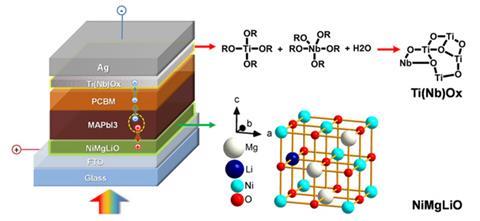Michael Grätzel’s team looks to cut through the hype with device tested by national test lab

Perovskite solar cells may one day rival silicon-based technologies, but their performance outside the laboratory has been a constant source of contention in the past year. Now, an international team of scientists has manufactured the first thin film perovskite solar cell with a reported efficiency that has been officially recognised by an accredited national test laboratory.1
Since their development in 2012, the performance of light-harvesting metal–organo halide structures has seemingly improved at a staggering rate, with their efficiency increasing by six percentage points in just two years – the same increase took multi-crystalline solar cells over two decades.
But their stability has been brought into question, with some international test centres taking issue with perovskite solar cells that are so unstable that they may degrade spontaneously in air, making it hard for them to assess their performance.
It’s a state of affairs that Michael Grätzel from the Ecole Polytechnique Fédérale de Lausanne in Switzerland has had trouble dealing with. ‘Conspicuously, you could see that from the very beginning there was very scarce information on the stability of these devices,’ comments Grätzel. ‘I have raised that issue many times – one would think that now everybody does stability work after this alarm was sounded, but not so.’
Grätzel explains that the perovskite cells currently being developed are often smaller than the required test standard of 1cm2, with research groups only managing to manufacture 0.1cm2 devices. This means the cells fall short of the criteria for accredited testing, which exposes a 1cm2 cell to 1000W/m sunlight for 1000 hours to see whether the device’s efficiency will drop.
‘You can count on one hand the number of studies that have applied those norms and test stability, [even though] there have been 1000 papers published in the last year on perovskites,’ comments Grätzel.
Substitution solution
Although research groups have focused on the perovskite structure quality to increase their size, Grätzel and his colleagues have adopted a different approach. A thin film perovskite light collector has a sandwich structure. Incoming light excites the perovskite layer and liberated electrons pass through a titania charge extraction layer on one side, with holes being transported through a NixMg1-xO lattice on the other. The team decided to leave the perovskite layer untouched and substituted the Ni(Mg)2+ and Ti4+ cations in the extraction layers with Li+ and Nb5+ ions. They found the conductivity of the device increased.
The group were also able to scale up the device to 1cm2 and test its stability. The solar cell’s efficiency, according to the group, is 16.2%, with the device retaining 90% of its initial performance after 1000hrs of light soaking. Although slightly lower than the team’s estimate, an efficiency measurement of 15% was verified by the National Institute of Advanced Industrial Science and Technology in Japan. This value has since been included in international solar cell efficiency tables.2
Eva Unger, a postdoc from Lund University in Sweden, whose recent work on perovskites has backed up Grätzel’s concerns, believes that any work on improving device stability is surely a good thing. ‘We know the material has certain issues,’ Unger tells Chemistry World. ‘Any improvement to enhance stability or any work understanding where instability stems from is really important, I think, in the development of this technology.’
Unger also goes on to explain that such research only reinforces the need for common ground on these issues in the perovskite community. ‘The community is such that we need to agree on common standards on how to establish long-term stability,’ she says. ‘There should be common measurement protocols as they were established in the OPV community or other solar cell communities.’












No comments yet